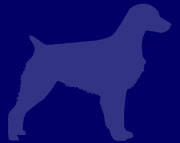| Click
here to visit the official website of the American Brittany Club |
 |
 |
|||||
Introduction to Dog Shows Adapted from the AKC's Beginner's Guide to Dog Shows
Each dog presented to a judge is exhibited ("handled") by its owner, breeder or a hired professional. The handler makes sure the dog gets into the proper ring at the proper time, keeps the dog alert and in control, and a talented handler will know how to show off the dog's best qualities for the judge to evaluate. Most dogs in competition at dog shows are competing for points toward their AKC Championships. It takes fifteen points, including two majors (wins of three, four or five points) awarded by at least three different judges, to become a Champion (indicated by a "Ch." in front of the dog's AKC registered name). The number of championship points awarded at a show depends on the number of males ("dogs") and females ("bitches") of the breed actually in competition. These points are awarded based on the number of dogs in actual competition--the more dogs, the more points. The maximum number of points awarded to a dog at any show is 5 points. Males and females compete separately within their respective
breeds. The following classes are offered, and are divided by sex: After these classes are judged, all the dogs that won first
place in a class compete again to see who is the best of the winning dogs.
Males and females are judged separately. The best male (Winners Dog) and
the best female (Winners Bitch) receive championship points. Winners Dog
and Winners Bitch then compete with the Champions for the Best of Breed
award. In the Best of Breed class, three awards are usually given: Best of Breed, Best of Opposite Sex, Select Dog and Select Bitch are also eligible for points towards the Grand Champion title. Points towards the GCH may only be earned after the dog has already obtained its Champion title. In an all-breed show, each Best of Breed winner advances to compete in the Group competitions. Each AKC-recognized breed falls into one of seven group classifications. The seven groups are Sporting, Hound, Working, Terrier, Toy, Non-Sporting and Herding. Four placements are awarded in each group, but only the first-place winner advances to the Best In Show competition. The seven Group winners compete for Best in Show, in which only one dog remains undefeated that day. Judges examine the dogs, then give awards according to how closely each dog compares to the judge's mental image of the "perfect" dog described in the breed's official standard, which includes specifications for structure, temperament and movement. The judges examine ("go over") each dog with their hands to see if the teeth, muscles, bones and coat texture conform to the standard. They view each dog in profile for overall balance, and watch each dog gait ("move") to see how all of those features fit together in action. Since some aspects of the standard are subject to interpretation, there is a different judge for the breed on each day of a dog show, so that dogs have the opportunity to be evaluated by many different judges. The AKC offers youngsters aged 9 to 18 the opportunity to compete with others their own age at various AKC events. Juniors competing in conformation events are judged on how they present their dogs. For information on competing in Junior Showmanship, see the AKC Website. Tips for the First-Time Spectator • Ask for permission before petting dogs (remember
the dog may have just been groomed in preparation for being judged).
Next Page: Getting Started in Dog Shows
|
|||||
[home] [faq] [brittany activities] [breed standard] [dual champions] [i want a britt!] [contact] [links] Images on this web site are copyrighted to the photographer, all rights reserved. Do not copy or use without permission. |
|||||